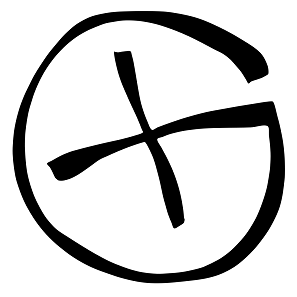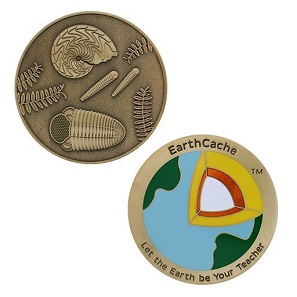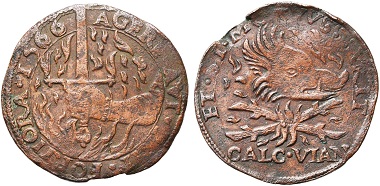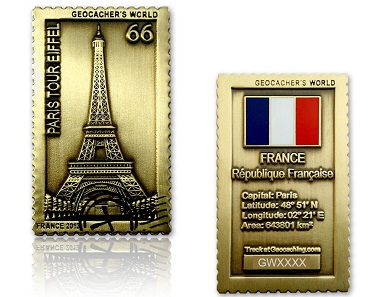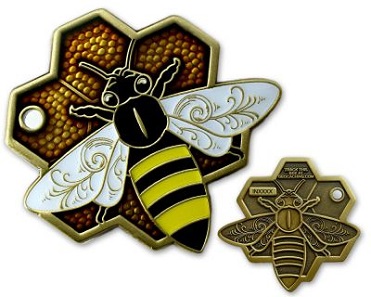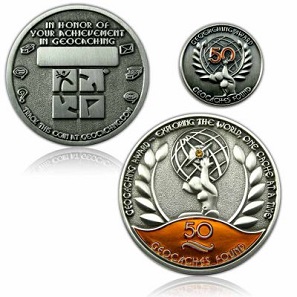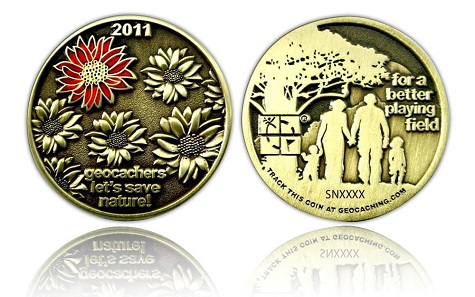Geocaching – A Numismatic Scavenger Hunt?
by Leonie Schulze
What do Hugh Jackman, Melissa Joan Hart and Dom Joly have in common? They are self-proclaimed geocachers – as are millions of other people around the world. Geocaching is the scavenger hunt of the 21st century. Forget scraps of paper with hints and riddles or chalk arrows drawn onto the sidewalk. Geocaching is done digitally and by using GPS signals. You are bound to discover all sorts of things on this scavenger hunt: bobby pins, CDs, books, balls, knitting kits, … and coins – so-called geocoins, and it was only a matter of time until those would become a field of collection in their own right.
The official international Geocaching logo.
48 degrees 47 minutes 32.129 seconds north – 9 degrees 12 minutes 55.488 seconds east
Two fundamental things changed when the artificial “selective availability” of the satellite-based navigation system GPS (Global Position System) was disabled in May of 2000: we no longer had to arduously unfold massive street maps on our cars’ passenger seats and the traditional scavenger hunt as we remembered it from our childhood came to end. Well, perhaps the causalities and developments were not quite this simple. However, the free usability, geographical accuracy, and cheap availability of the respective gadgets certainly was essential for geocaching to develop as a new hobby and recreational sport in the first place.
The first Sunday of the annual Earth Science Week is celebrated as Earthcache Day by geocachers all over the world. A corresponding official geocoin is issued every year. Photo: Geocoinshop.de.
That very same month, Dave Ulmer from Portland (Oregon) hid the first geocache and shared its coordinates in an internet forum. It only took a few hours before someone found the box. Within a few days, dozens of other part-time adventurers followed his example and began hiding appropriately marked Tupperware boxes in their surrounding countryside. The number of geocachers increased consistently in the following years. Today, several million people are said to engage in this hobby. Not all of them have registered on official geocaching websites like Geocaching.com or Opencaching.de.
This design imitates a 1566 counter of Hendrick van Brederode. Photo: Geocoinshop.de.
The model. The Netherlands. Counter 1566. From Jean Elsen Auction 139 (2018), no. 1323.
Before they set out on their quest, treasure hunters look up where geocaches are hidden in their vicinity. Depending on the indicated level of difficulty, they pack the appropriate gear – rain boots, gloves, batteries, ropes, helmets – and enter the coordinates into their GPS device. Geocaches come in different sizes: they might be as small as your thumbnail or as big as a shoebox. They just need to be waterproof. The respective boxes will then contain a logbook, which geocachers are encouraged to sign, as well as small treasures like toys, buttons, CDs, books, and coins.
Some of the designs for Geocoins combine a number of different hobbies. This is the seventh geocoin of the Geocacher’s World Geocoin series. Photo: Geocoinshop.de.
Geocoins as a field of collection
It is up to you whether or not you replace the objects you find in geocaches with something else. Some geocoins hidden in caches are intended to be travelling items, so-called trackables. They come with an inscribed serial number which allows for the tracking of the pieces’ journey. Some geocoins are also connected to specific missions you must accomplish before you are allowed to keep them. Others are explicitly marked as gifts and can immediately be added to your own collection.
The design is up to the person who orders the geocoin. Any group, organization, or individual person can have them minted. They are produced by private companies that specialize in the manufacturing of geocoins. The design options know no limits. Any shape or color minting technology currently allows can be used to make geocoins. In terms of topics and motifs, it appears as though there is nothing you cannot put on geocoins. Some feature Templars or the Oktoberfest in Munich, others depict dinosaurs and Teutonic images. So-called “geoachievements” can be rewarded with respective celebratory medals. Although geocaching has been around for less than 20 years, it has already been honored with commemorative geocents.
Geocoins do not have to be round in shape. This piece is designed to look like the cell of a honeycomb. Photo: Geocoinshop.de.
Geocoinfest – The convention for geocoin collectors
Wherever there are coin collectors, there will be a coin convention, too. The Geocoinfest was first organized in the United States in 2007. In 2011, Europe followed suit and initiated the Geocoinfest EU. The conventions take place in different cities every single year. Geocoinfests are essentially the same kind of event as the conventions and fairs we know from classical numismatics: dealers offer their geocoins and accessories at tables or booths, collectors seek their expertise, haggle for a few minutes and then opt for a piece they are particularly interested in.
Geocoins are also distributed as awards, e.g. to celebrate the 50th discovery of a geocache. Photo: Geocoinshop.de.
One small difference to traditional coin conventions which should be pointed out is the inevitable and extremely popular “Mega” geocaching event organized in the context of the conventions. Attendees set out on a quest to find caches in close proximity to the venue. Thousands of collectors visit one of the two Geocoinfests every single year. The next Geocoinfest EU will take place on September 7, 2019 in Manchester (UK). In the U.S., geocoin collectors will get together in Houma (Louisiana) from September 27 until September 29, 2019.
Portions of the proceeds of the Save our Playing Field geocoins are donated to organizations committed to fighting climate change. Photo: Geocoinshop.de.
The popularity of geocoins
In an episode of the “Podcasher” podcast, the founder and organizer of Geocoinfest, who is commonly known as “Avroair”, explained the charm of geocoins: “I think it is the most democratic collection that you can possibly get. By that I mean, it’s a collectible, but most of the time, when you have a collectible, you have one source, one company […]. [But] [a]nyone can make geocoins.” He emphasized that every single geocoin was unique and very personal in its design. Unfortunately, he noted, geocoins had moved away from this original idea in recent years and many of them were now manufactured specifically for people to buy them, instead of trading them.
Geocoins enjoy increasing popularity and have developed into a very active and multifaceted field of collection. It even appears as though some collectors have given up on the actual practice of geocaching entirely and have devoted themselves to finding different ways of obtaining new pieces. Why should you go to the trouble of running through the forest during a downpour if you can purchase the beloved pieces in a dry convention hall as well?
This video on the “Geocaching Etiquette” explains the dos and don’ts of geocaching.
Geocachers looking for new tips and events can subscribe to the German Geocaching-Magazin or the UK Cache Mag.
Fervent geocoin collectors have banded together as the Secret Society of Coin Addicts.




